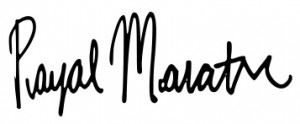Earlier this year, a photo of a Roman Originals dress was posted on Tumblr. Some looked at the picture and saw a garment of white and gold. Others swore that the dress was black and blue. The controversy quickly inspired Buzzfeed articles. Dressgate became a Twitter hashtag, and appeared all over Facebook news feeds. This divisive piece of clothing was separating people into camps — you were either #whiteandgold or #blackandblue. While plenty of people voiced strong opinions, only science provided a satisfying answer: The discrepancy could be attributed to chromatic adaptation. In processing visual information, the human brain has to subtract background inputs — otherwise we would perceive colors differently during the day and at night, in bright light versus dim light. Because the image is poor quality, the dress falls on a perceptual boundary. Different brains subtract different elements of background and lighting, which causes diverging interpretations of color.
Roman Originals saw a boom in sales. But more importantly, Dressgate offered advocates of white and blue alike a lesson in the science of vision, and it proved how ubiquitous science can be in popular culture. No longer should science bring to mind images of lab-coated researchers hunched over petri dishes — at least, not exclusively. No matter where your interests lie, science is unavoidable. It affects each of us in more ways than we can imagine, from determining how beautiful an orchestra sounds (pg. 31) to inspiring the well-known TV commercials for a certain vaccine (pg. 9).
So, with this issue of the Yale Scientific, we invite you to indulge in the science that informs everyday questions and curiosities. While you’ll find no article about a dress that went viral, you will learn about how engineers are using sensors to make our bridges safer (pg. 30). Sometimes, simple science holds power in solving great problems. A smartphone has been revamped into a diagnostic tool that will advance global health work (pg. 32), and the solution for secure, long-term information storage may be the A’s, C’s, G’s, and T’s of DNA (pg. 26). Other times, details in science can answer our simple questions and frustrations, as anyone who has ever tried to tickle herself will understand (pg. 2).
Admittedly, Yale Scientific writers visit labs, observe research in action, and interview experts. But even when science seems complex or faraway, it is always closer than we realize, as our cover story shows. Hibernating squirrels are harboring secrets that — if unlocked — could improve treatment for human cardiac trauma and could send us on more productive missions into space (pg. 24). As a publication dedicated to making science accessible, this issue also celebrates 10 years of a program that has bridged the gap between science’s most complicated theories and its youngest students (pg. 12).
On the pages that follow, you’ll see — perhaps surprisingly — that research from any field in science can have important daily relevance. As you read this magazine, I hope you find answers: to everyday puzzles, and to questions you didn’t know you had.
Sincerely,

